Thit Kho (Vietnamese Braised Pork with Eggs)

Susan Vu
February 16, 2023
This Vietnamese dish was on constant rotation in my household growing up and led to my eternal love for all things pork belly. It is a perfect meal when paired with hot steamed jasmine rice and a fresh crunchy vegetable (sliced cucumbers are a personal favorite).
The best versions of thit kho yield a sauce that is a perfect mix of sweet and deeply savory. To ensure that the sauce isn’t cloying, you must make a very dark caramel sauce called nước màu. It can be found in many Vietnamese dishes and is very different from traditional caramel sauce. Nước màu is granulated sugar and water cooked together until it is smoky and darkened to a hue just a touch lighter than soy sauce. This process will literally get smoky so make sure to crack a window or turn on your kitchen fan. But be fearless in how far you take this caramel because it is what will make or break your final thit kho — a too-light nước màu will lack the depth and slight bitterness needed to balance out the sauce.
The Anova Precision Oven is used two ways during the cooking process. It is first used to perfectly steam the eggs (hard-boiled but with the faintest jammy center) then the heat is increased slightly to braise the pork. Older eggs tend to be easier to peel so if possible, try to use eggs that have been in your refrigerator for at least a week (even longer is preferable). As eggs age, both the inner and outer membranes stick less to the white albumen which make the shells easier to peel.
Serves
6
Prep Time
01:00
Cook Time
03:30
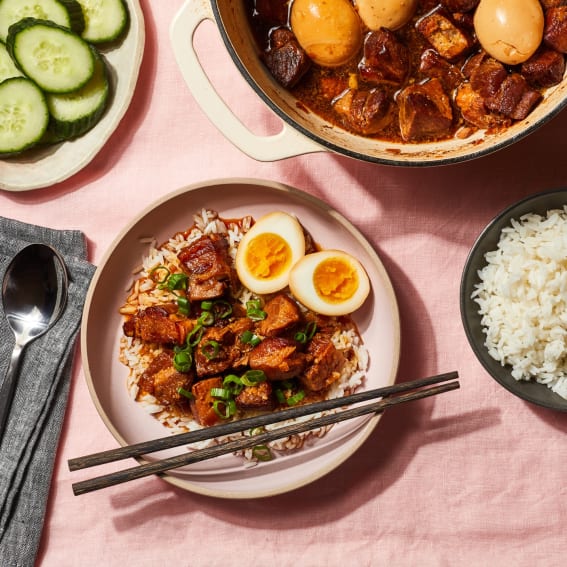
5 (1)
125
Ingredients
8
large eggs (straight from the refrigerator)
6 Tbsp (80g)
granulated sugar
6 Tbsp
room temperature water, divided
¼ cup
fish sauce
2 Tbsp
soy sauce
1.5 lb
skinless pork belly, cut into 1-inch pieces
1 lb
boneless pork shoulder, cut into 1-inch pieces
2 tsp
canola oil
2 large
shallots (110g), coarsely chopped (about 3/4 cups)
1.75 cups
unsweetened coconut water
4 cloves
garlic (12g), minced
3
star anise pods
Freshly ground black pepper
2
scallions (20g), thinly sliced (about 1/3 cup)
Steamed jasmine rice, for serving
Sliced English or Persian cucumbers, for serving (optional)
Steps
1. Preheat the Oven
Rack
Sous Vide Mode: Off
Steam: 100%
Temp: 213°F
Heat: Rear
2. Cook the Eggs
Rack
Arrange the eggs in a single layer onto a perforated pan or a wire rack set over a baking sheet.
Transfer to the oven and cook until the eggs are hard-boiled but with a faintly jammy center, 18 minutes exactly. Make sure to turn on the timer immediately after placing the eggs in the oven.
While the eggs cook, fill a large bowl with ice water.

Sous Vide Mode: Off
Steam: 100%
Temp: 213°F
Heat: Rear
00:18 Timer
3. Chill and Peel
Immediately transfer the cooked eggs to the prepared ice bath and let sit for 15 minutes.
Remove the eggs from the ice bath and one by one, gently roll the eggs on a flat surface then peel under cool running water in the sink. Don't worry about the eggs being perfectly peeled; it won’t be super noticeable in the final dish. Place the peeled eggs into a medium bowl and chill in the refrigerator.

4. Adjust the Oven for Braising
Rack
Sous Vide Mode: Off
Steam: 50%
Temp: 265°F
Heat: Rear
5. Make the Nước Màu (Vietnamese Caramel)
In a medium saucepan, combine the sugar and 2 tablespoons of the water and set over medium heat. Stir gently until the sugar dissolves, about 2 minutes. Stop stirring and continue to cook the sugar mixture until it darkens to a deep, dark brown hue just slightly lighter than soy sauce and the mixture is smoking, 5 to 10 minutes. The timing for this will depend heavily on your stovetop, but make sure to swirl the saucepan as needed to ensure even cooking.
Immediately turn off the heat and remove the saucepan from the hot stovetop. Carefully add 2 tablespoons of water to the saucepan (the mixture may sputter). Use a heat-safe rubber spatula to stir the caramel until completely smooth. Stir in the 2 remaining tablespoons of water, the fish sauce, and the soy sauce. Continue to stir until the sauce is well-combined and smooth then transfer the sauce to a large heat-proof bowl.
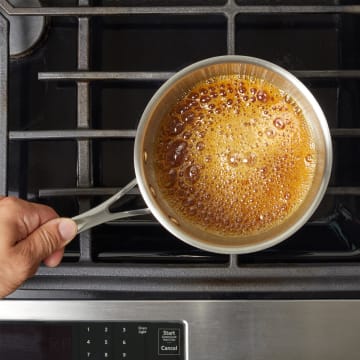
6. Coat the Eggs in the Sauce
Add the peeled eggs and stir to coat in the sauce. Once the eggs are completely coated, use a slotted spoon to transfer the eggs back into the bowl they were in. Chill the eggs in the refrigerator and leave the remaining sauce out at room temperature while you brown the pork.
7. Brown the Pork
In a 5-quart Dutch oven set just below medium-high heat, warm the canola oil. Once it's shimmering (but not smoking), add a third of the pork and brown on all sides, 6 to 8 minutes. Transfer the browned pork to the bowl with the sauce, stir to coat, and brown the remaining pork in two additional batches.
After all of the pork is browned, spoon out any rendered fat from the Dutch oven that exceeds 2 tablespoons (let the excess fat cool completely and discard or reserve to use as fat in other recipes).
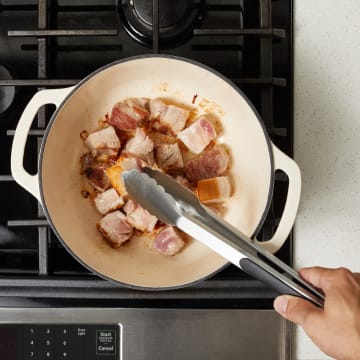
8. Make the Braising Liquid
To the empty Dutch oven, add the shallots and a splash of the coconut water. Use a rubber spatula or wooden spoon to scrape up any browned bits at the bottom of the Dutch oven and cook, stirring constantly, until the shallots are just starting to soften, about 3 minutes. Add the garlic and cook, stirring constantly, until softened, about 1 minute. Add the browned pork and the sauce back into the Dutch oven along with the remaining coconut water, star anise, and several large grinds of black pepper. Stir to combine.
Increase the heat to medium-high and bring the braising liquid to a simmer, 2 to 5 minutes.

9. Braise Pork
Rack
Cover the Dutch oven partially with a lid, leaving a 1/2-inch gap between the lid and one side of the Dutch oven.
Transfer to the oven and cook until the pork is fork-tender (but not falling apart) and the sauce is slightly reduced, 2 to 2 1/2 hours. Remove from the oven.
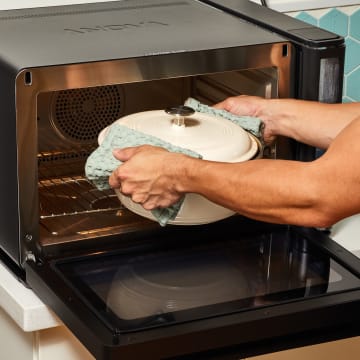
Sous Vide Mode: Off
Steam: 50%
Temp: 265°F
Heat: Rear
02:00 Timer
10. Reduce the Oven Temperature
Rack
Sous Vide Mode: Off
Steam: 50%
Temp: 250°F
Heat: Rear
11. Skim the Fat and Add the Eggs
While the oven temperature reduces, skim off most of the fat floating at the top of the braising liquid (let the excess fat cool completely and discard or reserve to use as fat in other recipes), and remove and discard the star anise.
Add the chilled eggs and use a spoon to gently nudge the eggs down into the braising liquid (they do not need to be completely submerged, but should be mostly covered).

12. Finish the Braise
Rack
Once the oven reaches the new lower temperature, cover the Dutch oven with the lid, and return to the oven. Cook until the eggs are warmed all the way through, about 30 minutes.
Sous Vide Mode: Off
Steam: 50%
Temp: 250°F
Heat: Rear
00:30 Timer
13. Turn the Eggs and Rest the Thit Kho
Remove the lid and use a spoon to gently turn the eggs in the braising liquid (this will ensure that the eggs are evenly browned all over), cover with the lid again, and rest the thit kho at room temperature for 10 minutes.
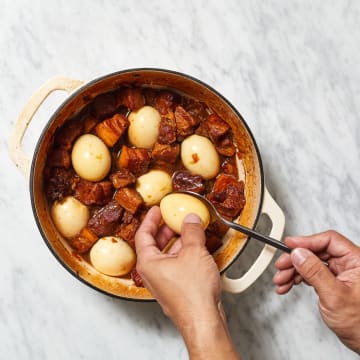
14. Serve
Garnish the thit kho with the sliced scallions and serve directly in the Dutch oven alongside steamed jasmine rice and sliced cucumbers (if using).
© 2013 - 2025 Anova Applied Electronics, Inc.